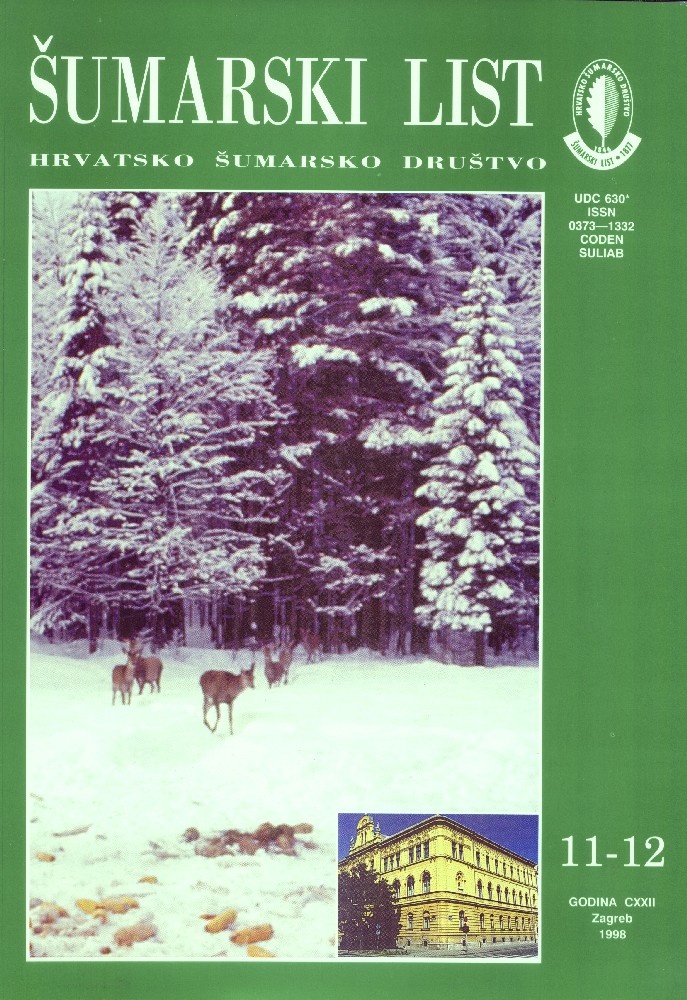
broj: 11-12/1998
pdf (21,9 MB) |
|
||||||||||||||
| IZVORNI ZNANSTVENI ČLANCI | ||
| Roša, J. | UDK 630* 165 + 168 + 48 (Quercus robur) 001. | |
| The Influence of Phosphogypsum From an Industrial Dump on the Pedunculate Oak (Quercus robur) pdf HR EN | 491 | |
| PRETHODNO PRIOPĆENJE | ||
| Domac, J. | UDK 630* 238 : 620. 91 | |
| Present and Future Energy Production from Forestry Biomass pdf HR EN | 507 | |
| PREGLEDNI ČLANCI | ||
| Grubešić, M., Krapinec, K. | UDK 630* 151 + 152 | |
| Colonization of the Beaver (Castor fiber L. in the Sava Valley pdf HR EN | 515 | |
| STRUČNI ČLANCI | ||
| Zelić, J. | UDK 630* 181.1 + 182.1 + 22 | |
| Autochthonism and Further Cultivation of Sweet Chestnut (Castanea sativa Mill.) in Požega Mountains pdf HR EN | 525 | |
| Summary: According to the latest hypothesis, sweet chestnut in the Požega region is not an autochthonous species, or a relict from the Terciary period as was believed until now. On the contrary, it was introduced, grown and harvested by the Romans in the period between the 1st and the 5th century A.D. Due to its wide range of usage, it was later accepted and cultivated by feudal estates, churches and monasteries in Croatia.The truth of this hypothesis might be confirmed by the concordance between present habitats of sweet chestnut and the remains of Roman roads, old fortified buildings, monasteries, Turkish fortresses and noblemen´s estates. We know with certainty that the Romans introduced wine-growing into these regions, which is confirmed by the fact that present vineyard sites are located along architectural objects from the past. Sweet chestnut has been artificially distributed northward as far as southern Poland, central Germany and Switzerland up to the 50th degree of latitude. It requires favourable site conditions (neutral or acid soil) and microclimatic properties (mean temperature over 11°C). Its biological characterises and properties enable sweet chestnut to regenerate very well. Chestnut blight, caused by the fungus Endithia parasitica, is spread throughout the chestnut distribution range in Croatia. The fungus species with hy-povirulent properties cause cancers. Chestnut was a very important nutritional product before extensive potato and maize cultivation began in Europe in the seventeenth century. This paper presents some basic indicators necessary for the cultivation and preservation of sweet chestnut forests in the Požega mountains. The comparative research method was used for this aim. Key words: archaeological finds of Roman roads and buildings; comparative research method; old towns and settlements; Požega mountains; Požega valley; present situation and possibilities of cultivation.; Romans; sweet chestnut | ||
| Đuričić, I., Đuričić-Kuric, T. | UDK 630* 907.1 : 719 + 72.02 | |
| Wineyard Cottages on Southern Slopes of Mount Kalnik pdf HR EN | 537 | |


